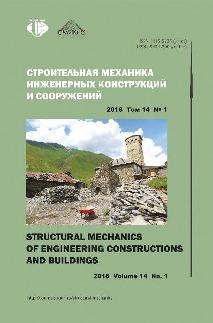RESOLVING EQUATIONS OF PLANAR DEFORMATION IN CYLINDRICAL COORDINATES FOR PHYSICALLY NONLINEAR CONTINUUM
- Authors: BAKUSHEV S.V1
-
Affiliations:
- Penza State University of Architecture and Construction, Russian Federation
- Issue: Vol 14, No 1 (2018)
- Pages: 38-45
- Section: Theory of elasticity
- URL: https://journals.rudn.ru/structural-mechanics/article/view/17793
- DOI: https://doi.org/10.22363/1815-5235-2018-14-1-38-45
Cite item
Full Text
Abstract
For planar deformations of continuum, which mechanical behavior is described by mathematical models, where physical relations have the form of cross dependence derivatives between the first invariant of the tensor and the second invariant of the voltage and stress deviator, the development of resolving equations in displacements in cylindrical coordinates is being analyzed. Two models are analyzed as examples: deformation theory of loose medium plasticity and deformation theory of concrete plasticity. The resolving equations system is a system of two quasilinear differential equations of second order at quotient derivatives from two independent variables - the displacement of continuum points at radial and tangential directions. Iteration methods are suggested for its integration. It is recommended to take the discussed question solution for physical linear continuum as initial solution approximation. Received equations can be used at evaluation of stress-strain state of physically nonlinear massive bodies with complex geometry.
About the authors
SERGEY V BAKUSHEV
Penza State University of Architecture and Construction, Russian Federation
Author for correspondence.
Email: bakuchsv@mail.ru
DSc (in Technical Sciences), Professor, professor of Department of Mechanics, the Penza State University of Architecture and Construction, Russia. Scientific interests: theory of elasticity, geometrical and physic non-linear mechanics of continuous mediums, physically non-linear solid body
28 Titov St., Penza, 440028, Russian FederationReferences
- Ishlinskii, A.U., Ivlev, D.D. (2001). Mathematic Theory of Plasticity. Moscow: Fizmatlit publ. 704. (In Russ.).
- Bell, J.F. (1973). Mechanics of Solids. Volume I: The Experimental Foundations of Solid Mechanics. Springer-Verlag Berlin Heidelberg.
- Geniev, G.A. (1974). About the question of the deformation theory of plasticity of granular medium. Structural Mechanics and Analysis of Constructions, No 4, 8—10. (In Russ.).
- Geniev, G.A., Kissyuk, V.N., Tyupin, G.A. (1974). Teoriya Plastichnosti Betona i Zhelezobetona [Theory of Plasticity of Concrete and Reinforced Concrete]. Moscow: Stroiizdat publ. 316. (In Russ.).
- Novozhilov, V.V. (1958). Teoriya Uprugosti [The Theory of Elasticity]. Leningrad : Sudpromgiz publ. 370. (In Russ.).
- Aleksandrov, A.V., Potapov, V.D. (2002). Soprotivlenie Materialov. Osnovy Teorii Uprugosti i Plastichnosti [Strength of Materials. Fundamentals of the Theory of Elasticity and Plasticity]. 2nd revised edition. Moscow: Vysshaya Shkola publ. 400. (In Russ.).
- Bakushev, S.V. (1981). About regularities of deformation wave transmission in inelastic loose medium. Cand. of Science in Engineering (Dissertation). Moscow, 158. (In Russ.).
- Bakushev, S.V. (2004). Geometrically nonlinear variant of a deformation theory of concrete elasticity. Concrete and Reinforced Concrete, No 2, 19—23. (In Russ.).
















